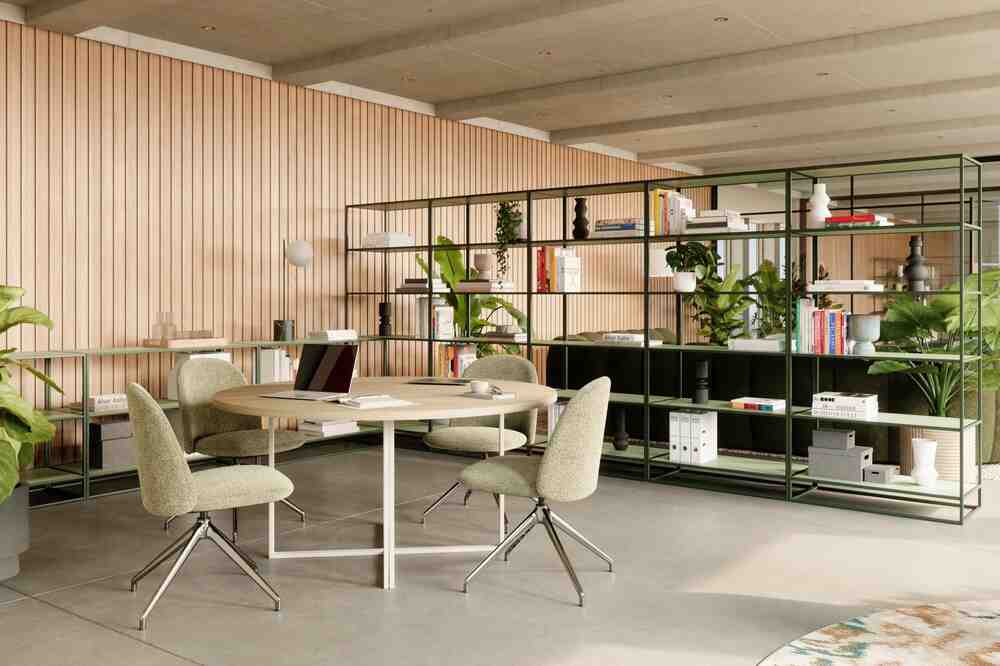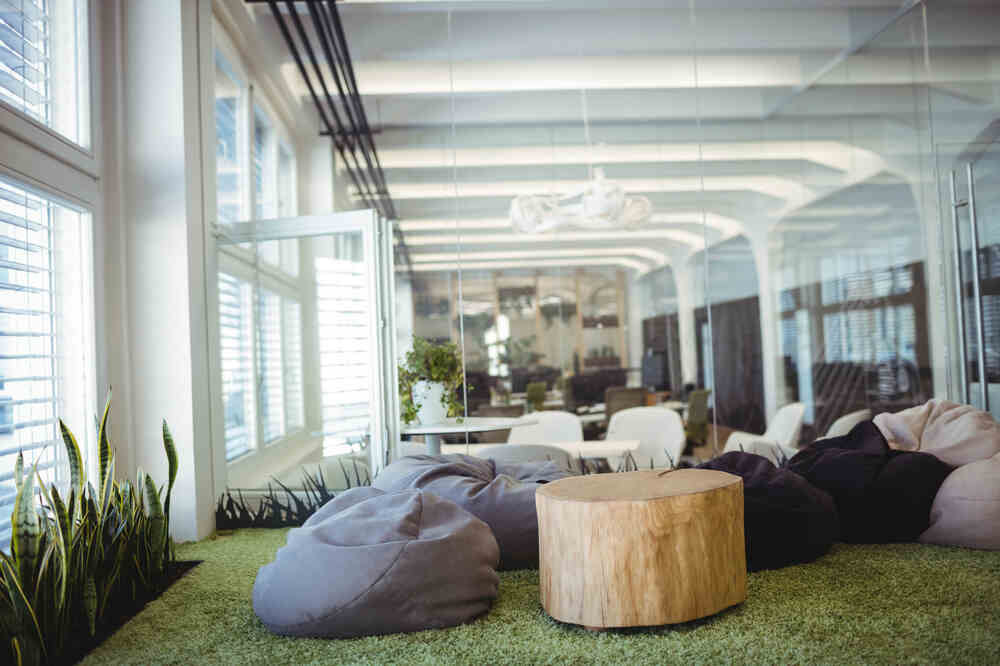
Biophilic office design is gaining attention for its ability to bring natural elements into the workplace, creating a more comfortable and productive environment. Office spaces can feel more inviting and less stressful by incorporating nature-inspired touches. Using green office furniture is a simple and effective way to achieve this, blending functionality with design that promotes well-being.
Here are six practical ideas for adding biophilic elements to essential office furniture pieces to create a workspace that feels fresh, natural, and inspiring.
Key Takeaways✔ Incorporating natural elements into office desks, like greenery and natural light placement, fosters a calming and visually appealing workspace. ✔ Ergonomic chairs with earth-toned covers, wooden armrests, and natural chair mats enhance comfort while blending with biophilic themes. ✔ Cabinets can serve as functional green accents by hosting cascading plants, magnetic planters, or nature-inspired decor. ✔ Guest chairs with natural fabrics, earthy cushions, and strategic placement near greenery create a welcoming and cohesive office atmosphere. ✔ Lounge furniture paired with biophilic accessories like nature-themed pillows, live-edge tables, and central plants fosters collaboration and relaxation. ✔ Architectural walls featuring green panels, organic patterns, and strategic natural lighting help define office spaces while enhancing biophilic design. ✔ Maintaining biophilic design requires consistent care for plants, regular updates to decor, and active engagement from employees to preserve the connection to nature. |

Office desks are central to productivity, and incorporating biophilic elements into their setup can transform the workspace into a more inviting and calming environment. By integrating natural features, desks can encourage focus, creativity, and well-being. Simple adjustments to desk layouts and accessories can make a significant difference in fostering a nature-inspired workspace.
Ergonomic chairs are essential for workplace comfort, but they can also contribute to a biophilic office design with subtle additions. By focusing on colors, textures, and accessories, these chairs can connect employees to nature while maintaining functionality. Small, thoughtful changes can turn ergonomic chairs into a harmonious part of a nature-inspired workspace.
Cabinets are a practical part of any office, but they can also enhance a biophilic design when paired with natural touches. By combining utility with greenery, cabinets become more than just storage—they add vibrancy to the workspace. A few simple upgrades can turn cabinets into eye-catching features of a nature-inspired workspace.
Guest chairs are an important part of making visitors feel comfortable, and adding biophilic elements to these chairs creates a welcoming atmosphere. With thoughtful materials and placement, guest chairs can reflect the natural, calming theme of the workspace. These enhancements ensure the seating feels inviting and aligned with a green office furniture approach.

Collaboration and lounge furniture bring teams together and serve as key elements in creating a relaxing, creative space. By incorporating biophilic elements, these areas become positive meeting points and inspire innovation and comfort. Thoughtful furniture arrangements and natural accents help foster a truly nature-inspired workspace.
Architectural walls are versatile elements that define office spaces, and incorporating biophilic design into them can elevate the workspace. These walls can serve as visual focal points, partitions, or accents while seamlessly blending natural elements. Using greenery, patterns, and materials thoughtfully ensures they contribute to a nature-inspired workspace.
Sensory elements play a crucial role in biophilic office design by engaging employees’ senses to create a calming and inspiring environment. By incorporating features that stimulate sight, sound, touch, and smell, offices can foster a deeper connection to nature. These elements complement the use of green office furniture and enhance the overall experience of a nature-inspired workspace.
Using natural scents in the office can create a calming and refreshing ambiance. Essential oil diffusers with scents like eucalyptus, lavender, or cedarwood evoke the feeling of being outdoors and help reduce stress. Consider placing diffusers near workstations or common areas to promote relaxation. Scented candles or natural air fresheners in subtle fragrances can also enhance the sensory experience while maintaining a professional setting.
Water features, such as small fountains or water walls, introduce a gentle, flowing sound that helps mask office noise. The sound of running water is proven to reduce stress and improve concentration. These features can be installed in reception areas or lounges to create a peaceful focal point. To maintain practicality, choose compact, low-maintenance designs that fit seamlessly into the workspace.
Incorporating natural textures into office decor adds a tactile dimension to the environment. Rugs made from jute or sisal, wooden table surfaces, or stone accents bring earthy, organic elements into the office. Employees can interact with these textures, creating a sensory experience that fosters comfort and connection. Textured wall panels or partitions can also double as acoustic dampeners, further enhancing functionality.
Art inspired by nature, such as paintings of landscapes or botanical prints, creates visual interest and reinforces the biophilic theme. Large murals of forest scenes or ocean waves can act as statement pieces in collaborative spaces. For a more dynamic option, consider digital screens displaying rotating images of natural environments. This visual stimulation provides employees with a refreshing mental break.
Lighting that replicates the qualities of natural daylight supports a healthy, energizing workspace. Full-spectrum LED lights create a balanced glow that mimics sunlight and reduces eye strain. Installing dimmable lighting options allows employees to adjust the brightness according to their needs. Layering lighting with natural materials, such as wood or rattan fixtures, enhances the connection to a nature-inspired workspace.
Interactive greenery, such as herb gardens or vertical plant walls, allows employees to connect directly with natural elements. Create a small communal herb garden where employees can pick fresh basil, mint, or rosemary. Alternatively, install living walls that include touchable plants to provide a hands-on connection to nature. These features not only improve air quality but also encourage mindfulness and collaboration in the office.
Maintaining biophilic office design requires consistent care and thoughtful updates to preserve the connection to nature. Over time, greenery and natural elements may need adjustments to stay vibrant and functional. By following these practices, offices can ensure their biophilic features and green office furniture remain impactful and inspiring for employees.
Greenery is a cornerstone of biophilic office design, but plants require regular care to thrive. Assign responsibility for watering, pruning, and monitoring plant health to a designated individual or team. Use self-watering pots or automated irrigation systems to simplify maintenance. Routinely replace plants that show signs of stress to keep the workspace fresh and lively.
To avoid plants becoming overexposed to sunlight or airflow, rotate their placement every few months. This prevents damage to the greenery and ensures even distribution of biophilic elements throughout the office. For example, move plants from sunny desks to shaded areas to give them a break and refresh their environment. Rotating plants also provides employees with a renewed sense of novelty and connection to their workspace.
Natural elements like green walls, wooden accents, and textured decor require periodic cleaning to maintain their appeal. Dust plant leaves with a damp cloth to ensure they remain vibrant and photosynthetically active. Wipe down wooden furniture and stone surfaces with appropriate cleaners to preserve their natural luster. For larger installations like water features, schedule professional maintenance to prevent build-up and ensure functionality.
Seasonal updates help keep a biophilic office design dynamic and engaging. Introduce new plant varieties, such as poinsettias during winter or bright blooms in spring, to reflect the changing seasons. Swap out accessories like cushions, rugs, or artwork to align with seasonal themes. These updates refresh the workspace while reinforcing the connection to a nature-inspired workspace.
Over time, green office furniture may show signs of wear, which can detract from the overall biophilic design. Inspect furniture regularly for scratches, fading, or structural issues. Refinish wooden surfaces or replace worn textiles with fabrics in natural tones to restore their appeal. Keeping furniture in excellent condition ensures it remains a key part of the biophilic theme.
Involve employees in maintaining the biophilic design by encouraging them to personalize their spaces with small plants or nature-themed decor. Create opportunities for teams to participate in activities like repotting plants, planting herb gardens, or selecting new accessories. This engagement fosters a sense of ownership and ensures the biophilic office design remains a vibrant, shared effort.
Yes, biophilic office design can be effectively applied in small or home office spaces with a few adjustments. Focus on compact elements, such as small potted plants, a mini water feature, or a nature-inspired desk mat. Wall-mounted shelves or hanging planters can help incorporate greenery without taking up valuable floor space. Additionally, using natural light and adding decor in earthy tones can create a sense of connection to nature, even in limited areas.
Biophilic design doesn’t have to be costly and can be scaled to fit different budgets. Simple changes, like introducing plants, rearranging furniture near natural light, or using nature-inspired art, are affordable ways to start. Larger investments, such as green walls or custom furniture, can be made gradually as part of a long-term plan. Prioritizing low-maintenance elements also reduces ongoing costs while preserving the biophilic atmosphere.
Biophilic office design has a positive effect on employee retention by creating a healthier, more enjoyable work environment. Employees are more likely to feel satisfied and less stressed in spaces that incorporate natural elements, improving their overall well-being. A workplace that prioritizes comfort and aesthetics often results in greater employee loyalty and reduced turnover. Additionally, the connection to nature can enhance creativity and engagement, making employees more invested in their work.
Yes, there are certifications that recognize biophilic design in offices, such as the WELL Building Standard and LEED certifications. These programs evaluate a building’s design, materials, and practices to ensure they support health, sustainability, and biophilic principles. Pursuing such certifications can provide validation for a company’s commitment to wellness and environmental responsibility. While not mandatory, these certifications can help guide businesses in implementing effective biophilic strategies.
Absolutely, biophilic design complements technology-heavy workspaces by balancing modern elements with natural features. For instance, incorporating greenery around monitors or using adjustable lighting that mimics daylight can reduce the strain of screen-heavy tasks. Technology can also enhance biophilic design, such as using apps to control smart lighting or display dynamic nature scenes on digital screens. This integration creates a harmonious workspace that supports both productivity and well-being.
Stamford Office Furniture in White Plains, NY, offers a wide range of high-quality office furniture designed to enhance productivity and style in any workspace. Whether outfitting a corporate office or creating a collaborative environment, our selection includes ergonomic chairs, functional desks, and innovative storage solutions that align with modern design trends. With a focus on durability and functionality, Stamford Office Furniture ensures your office is both efficient and visually appealing.
Visit us today to explore furniture options that elevate your workspace and meet the needs of your growing business.